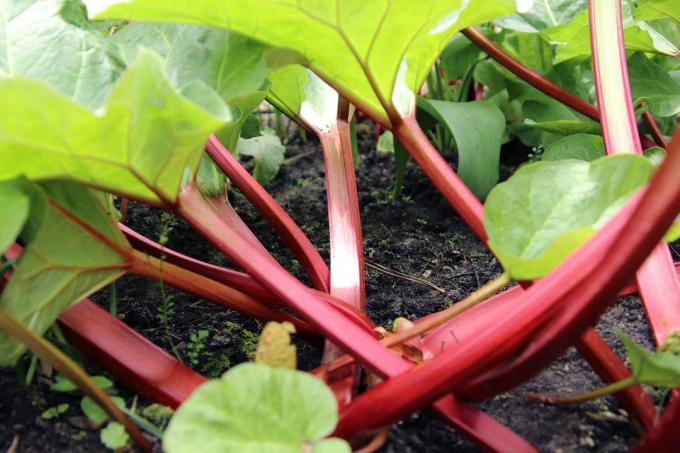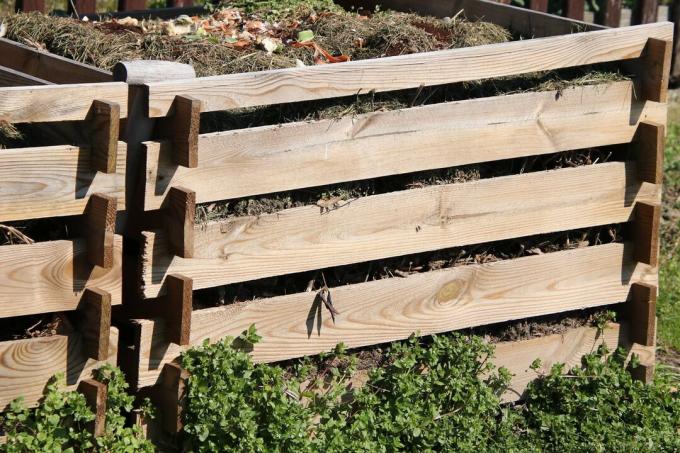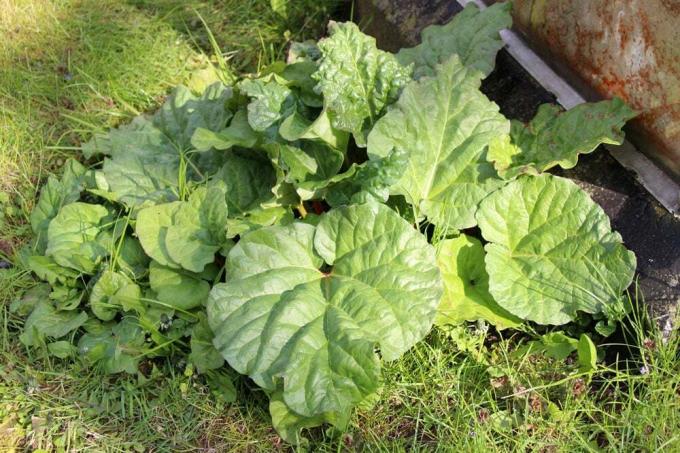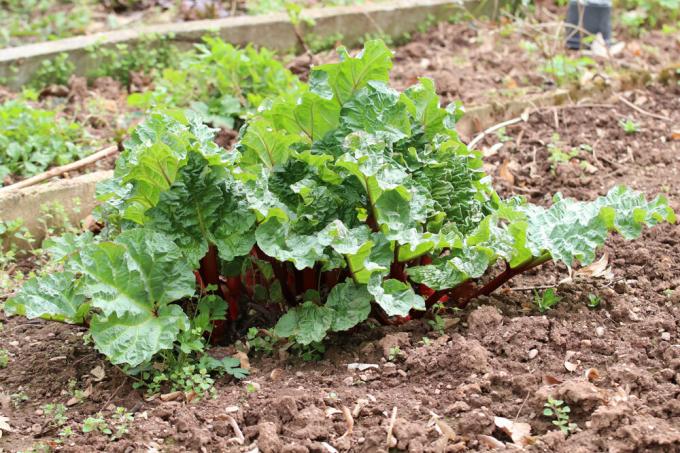

Table of contents
- Organic or mineral?
- The right moment
- Organic Fertilizers
- mature compost
- plant manure
- Horn shavings, horn semolina or horn meal
- horse manure
- mineral fertilizers
- frequently asked Questions
Properly prepared, rhubarb is a real treat. However, in order to thrive, it needs sufficient nutrients. The right fertilizer plays an important role in this.
Organic or mineral?
Rhubarb is one of those heavy feeders, so it needs plenty of nutrients. There is much to be said for organic fertilizers with a long-term effect. But why should they be given preference over mineral fertilizers?
- decompose slowly
- provide plants with long-term nutrients
- promote humus formation, improve soil structure
- Over-fertilization hardly possible, low risk of leaching
- mineral fertilizers, higher nutrient concentration
- Over-fertilization quickly possible
- Effect immediately, but only for a short time
- no benefit for soil and soil organisms
- can the PH value affect the soil

The right moment
Basically, rhubarb should be fertilized two to three times a year. The first fertilization should be done when planting. From the second year onwards, fertilize before or with the sprouting in early spring for the first time between the end of March and the beginning of April. Right after the Harvest at the end of June the second application of fertilizer follows. Rhubarb can also be fertilized in autumn about two weeks before the first frost.
Organic Fertilizers
mature compost
Compost is a valuable fertilizer that is ideal for fertilizing rhubarb. It is suitable for both spring and autumn fertilization. However, it should be well seasoned, i.e. ripe, which is the case after nine to ten months at the earliest. But then it should be used up as soon as possible, because the longer it stands, the more the nutrient content drops.
- suitable for year-round fertilization
- sieve before fertilizing
- Apply generously during the growth phase
- about three liters per square meter
- approx. two to five centimeter thick layer
- Work flat into the ground
- ideally with three handfuls of horn shavings

After a maturing period of six months, one speaks of "fresh compost". It contains a particularly large number of readily available nutrients, but is not suitable for fertilizing, as it would burn the roots. In this state of maturity it should only be used for mulching.
Tip:
A mulch layer of leaf compost or grass clippings protects against dehydration and provides the rhubarb with additional nutrients.
plant manure
Plant manure is a highly effective fertilizer for heavy-duty rhubarb. They contain a lot of nitrogen and potassium, which ensures vigorous growth. One Manure from nettles is particularly suitable for fertilizing. But how do you make them and what should you watch out for when fertilizing?
- from 1 kg fresh or 250 g dried herb
- Roughly chop the stinging nettles, add 10 liters of water
- in containers made of plastic, wood or earthenware, not metal
- place in a sunny place, cover, stir daily
- ready to use when liquid manure is no longer foaming
- sieve and dilute (1 part liquid manure/ 10 parts water)
- administer over the irrigation water

Plant manure is a good source of nitrogen after harvest. It is also ideal for subsequent fertilization in spring during the main growth phase. You pour directly onto the root area.
There are things you can do to soften the strong smell of the liquid manure during fermentation rock flour add.
Horn shavings, horn semolina or horn meal
Also animal legacies like horn shavings are a suitable fertilizer for rhubarb, preferably in combination with compost. These are almost pure nitrogen fertilizers. The proportions of sulphur, potassium and phosphorus are comparatively low. The application is also very simple here.
- for fertilization in spring and autumn
- in spring rather horn semolina or horn meal
- about two to four weeks before planting
- It is best to incorporate horn shavings in autumn
- in the planter even during the growth phase
- distribute all horn fertilizers generously around plants
- Work in lightly, then pour well

With these fertilizers, the granulation determines the efficiency. While horn shavings (grain size over five millimeters) are more likely to be regarded as long-term fertilizers, horn semolina (between a and five millimeters) and horn meal (under one millimeter) faster, but only for a short time, they are faster used up.
Tip:
Mixing horn shavings with compost makes sense in that compost accelerates the release of nitrogen and provides additional nutrients and trace elements.
horse manure
Another effective fertilizer for rhubarb is horse manure. It is also rich in nutrients and should be well seasoned for at least a year to avoid over-fertilization. The first dose of manure can be given as early as January or March, because horse manure can also protect the plants from frost. An additional application of fertilizer is usually not necessary with manure because its effect lasts for a relatively long time.
mineral fertilizers
Many hobby gardeners also put mineral fertilizers such as blue grain a. It provides a lot of nutrients in the short term, but these are not sufficient for rhubarb in the long run. There is also a risk of over-fertilization and leaching of dissolved salts into the groundwater. Who this fertilizer should use it in the spring during the Apply growth phase and always use it with caution.

frequently asked Questions
Yes, but only in smaller quantities, because coffee grounds easily acidify the soil. It is best to add it to the compost heap and then administer it over the compost.
In order to achieve consistently good yields, you should change location every eight to ten years.
Nutrient deficiency usually manifests itself in yellow discolored leaves. From August, this can also be an indication that the perennial is moving in or growing. in the hibernation goes.
 Mandy
Mandy
Learn more about rhubarb

Rhubarb location: 4 important criteria
Rhubarb, which is related to sorrel, is a fruity, sour stem vegetable that can be harvested from around April. It is hardy, extremely easy to care for and needs a new location every few years. The harvest season traditionally ends on St. John's Day, the 24th. June.

How deep is rhubarb rooted? | Root depth information
How deep is rhubarb rooted? Everyone who wants to implement the plant must ask themselves this question. Because the dimensions are important both for digging up the plant and for digging the new planting hole. Here is the answer.

Pruning rhubarb after harvest - how is it pruned?
Rhubarb - which is actually a vegetable - is a popular topping for cakes and tasty as a compote. As a garden plant, however, it poses many a puzzle. This includes the cut. Interested parties can find out when it makes sense and when not.

Transplanting rhubarb | the best time to plant | planting time
Fruity, juicy and full of vitamins - if you plant rhubarb in your garden, you always have an aromatic vegetable at hand for summer desserts or cakes. But when cultivating the popular vegetable, it should be borne in mind that the delicious sticks need to be moved from time to time in order to produce a rich harvest.

Cooking rhubarb jam - basic recipe
Rhubarb, a wonderfully old-fashioned vegetable, is back in fashion, at least in the kitchen. There are now different breeds with green or red flesh and they grow almost by themselves in the garden. Until the 24th It should be harvested and processed by June. The classic is rhubarb jam, and with good reason.

Harvest rhubarb - this is the best harvest time
Rhubarb is a fascinating vegetable that enjoys great popularity and can be found in many private gardens. No wonder: it tastes good, can be used in many ways in the kitchen and is relatively easy to grow. The crux of the matter is usually the harvest and the question of when the harvest can take place. Here are the answers.
